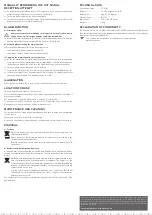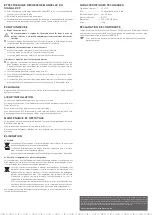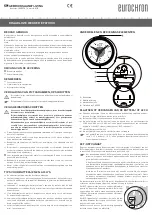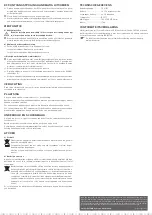
radio-controlled alarm clock eFW 1000
oPerating instructions
item no. 1295572 / Version 02/15
intended use
The product is intended for displaying the time of day; in addition, there is an inte-
grated alarm function.
The time is set automatically using an integrated DCF receiver.
Any use other than that described above could lead to this product being damaged
and involves the risk of short-circuiting, fire, electric shock, etc.
No part of the product may be modified or converted.
The safety instructions must be observed at all times.
This product complies with the applicable national and European requirements. All
names of companies and products are the trademarks of the respective owners. All
rights reserved.
Package contents
-
Radio-controlled alarm clock
-
Operating Instructions
Features
-
Crescendo alarm
-
Snooze function (repeated alarm)
-
Clock face light
exPlanation oF symbols, labels
m
This symbol indicates specific risks associated with handling, function and
use.
This symbol indicates special tips and notes on operation.
saFety instructions
m
First, read the complete operating instructions carefully, as they con-
tain important information about proper operation of the device.
damage due to not following these operating instructions will void the
warranty! We do not assume any liability for any resulting damage!
We do not assume any liability for material and personal damage caused
by improper use or non-compliance with the safety instructions! in such
cases, the warranty will be null and void!
-
For safety reasons, any unauthorised conversion and/or modification of the
product is not permitted.
-
Do not expose the product to high temperatures, strong vibrations or heavy me-
chanical loads.
-
If you have any doubts about the correct operation, or the safety of the product,
please consult a specialist.
-
This product is not a toy and does not belong in the hands of children. Use the
product only out of the reach of children; the product contains parts that can be
swallowed as well as a battery.
-
Do not leave packaging material lying around carelessly. They may become a
dangerous plaything for children.
-
Handle the product with care; it can be damaged by impacts, blows, or an ac-
cidental drop, even from a low height.
-
Note also the safety instructions in the individual sections of this operating
guide.
notes on batteries and rechargeable
batteries
-
Batteries/rechargeable batteries do not belong in the hands of children.
-
Do not leave batteries/rechargeable batteries lying around; there is a risk of
them being swallowed by children or pets. If they are swallowed, consult a doctor
immediately.
-
Leaking or damaged batteries/rechargeable batteries in contact with the skin
can cause acid burns; therefore, use suitable safety gloves.
-
Batteries/rechargeable batteries must not be short-circuited, opened or thrown
into fire. There is a risk of explosion!
-
Do not recharge normal, non-rechargeable batteries; risk of explosion! Only re-
charge rechargeable batteries that are intended for this purpose; use a suitable
battery charger.
-
Make sure that the polarity is correct when inserting the battery/rechargeable
battery (pay attention to plus/+ and minus/-).
controls and Parts
(1) Battery compartment
(2) Alarm setting knob
(3) Alarm switch
(4) SNOOZE button
inserting and rePlacing batteries/
rechargeable batteries
-
Open the battery compartment (1) on the back of the case and insert an AA/
Mignon battery, paying attention to the correct polarity.
-
The correct polarity is indicated at the battery compartment.
-
After inserting the battery, the clock hands move to the reception position
(12:00 noon, 04:00 am or 08:00 am), and the radio alarm clock starts to search
for the DCF signal (see chapter „DCF reception“).
-
Close the battery compartment (1).
-
The battery needs to be replaced if the clock stops.
The use of rechargeable batteries is possible. However, the lower operating
voltage (rechargeable battery = 1.2 V, battery 1.5 V) and lower capacity will
reduce the operating time.
dcF recePtion
Immediately after the battery is inserted, the device makes a first attempt to receive
the DCF signal. The hands of the clock run to the reception position and automati-
cally set themselves to the current time after successfully receiving the DCF signal.
The detection of the DCF signal and its analysis lasts a few minutes. Do not
move the radio-controlled alarm clock during this time. Do not press any
buttons or switches!
Bad reception can occur, for example, by metallised insulated glass, rein-
forced concrete buildings, coated special wallpapers, proximity to electronic
devices, or installation in cellars.
If after 10 minutes the hands have not moved to the current time, change
the location of the radio alarm clock and remove the battery. After approx.
one minute insert the battery again. This will start a new reception attempt.
The DCF time is automatically synchronised every day. This is sufficient to keep the
deviation less than one second per day.
The DCF signal is encoded and transmitted via a DCF
transmitter in Mainflingen (near Frankfurt am Main).
Its range is up to 1500 km and, under ideal reception
conditions, even up to 2000 km.
Among other things, the DCF signal includes the pre-
cise time (theoretical deviation of one second in a
million years!) and the date.
Naturally, this also eliminates the hassle of manually
setting up summer and winter times.
1500 km
2000 km


























